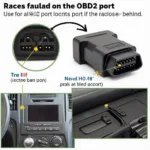OBD2 PIDs are the key to unlocking your car’s hidden data. They are standardized codes that allow OBD2 scanners to access specific information from a vehicle’s computer. Understanding what these PIDs are can help you diagnose car problems, monitor performance, and even improve fuel efficiency.
What exactly are these mysterious PIDs, and why should you care? PIDs, or Parameter IDs, are hexadecimal codes that represent specific pieces of data stored within your vehicle’s Engine Control Unit (ECU). Think of them as the address labels for the information your car’s computer holds. Each PID corresponds to a particular parameter, such as engine speed, coolant temperature, or fuel pressure. By requesting these PIDs, your OBD2 scanner can retrieve and display this data, giving you valuable insights into your car’s inner workings. For instance, if you’re experiencing rough idling, accessing the relevant PIDs can help pinpoint the cause, be it a faulty sensor or a mechanical issue. Want to know if your car is running lean or rich? The right PIDs can tell you.
Understanding OBD2 PIDs: A Deeper Dive
OBD2 PIDs follow a standardized format, ensuring compatibility across different vehicle makes and models. This standardization is a huge advantage, allowing mechanics and car enthusiasts to use the same diagnostic tools and techniques regardless of the car they are working on. This universal language of diagnostics simplifies troubleshooting and empowers car owners with the knowledge they need to understand their vehicles better. You can learn more about specific manufacturer PIDs like obd2 pids mazda.
How OBD2 PIDs Work
When you plug an OBD2 scanner into your car’s diagnostic port, it communicates with the ECU by requesting data associated with specific PIDs. The ECU then responds with the requested information, which the scanner displays in a readable format. This process allows you to monitor real-time data, view historical data logs, and even identify potential problems before they become major headaches. This is invaluable for preventative maintenance and understanding the overall health of your vehicle.
The number of available PIDs varies depending on the vehicle and its manufacturer. Some common PIDs provide basic information like engine speed and coolant temperature, while others offer more specialized data such as oxygen sensor readings and fuel trim values. Understanding what each PID represents is crucial for interpreting the data correctly and making informed decisions about maintenance and repairs.
Why Are OBD2 PIDs Important?
OBD2 PIDs offer a wealth of information that can be used for various purposes, including:
- Diagnostics: Identifying the root cause of check engine lights and other car problems.
- Performance Monitoring: Tracking engine performance, fuel efficiency, and other key metrics.
- Maintenance: Scheduling preventative maintenance based on real-time data and identifying potential issues early on.
- Customization: Tuning engine parameters and customizing vehicle settings for optimal performance (for advanced users).
For example, you can find specific PIDs for certain applications, like ng900 pids obd2 torque. Having access to this specific information can help you understand your vehicle’s performance characteristics better.
Decoding the Data: Common OBD2 PIDs and Their Meanings
While there are hundreds of PIDs, some are more commonly used than others. Familiarizing yourself with these common PIDs can empower you to take a more proactive approach to vehicle maintenance.
- Engine RPM (010C): Indicates the engine’s speed in revolutions per minute.
- Coolant Temperature (0105): Shows the engine coolant temperature.
- Vehicle Speed (010D): Displays the vehicle’s speed as reported by the ECU.
- Fuel Rail Pressure (0122): Indicates the pressure of the fuel being delivered to the engine.
Even specific vehicle features like tire pressure monitoring systems can be accessed through OBD2 PIDs, such as subaru tpms obd2 pids.
Using OBD2 PIDs with Diagnostic Software
Many OBD2 scanners come with their own software or are compatible with third-party applications. These software programs often provide a user-friendly interface for viewing and interpreting PID data. Some software even allows you to create custom dashboards, log data over time, and generate reports, offering a powerful toolset for both DIY mechanics and professional technicians. Consider applications like torque obd2 app pids chevy lumina for further data analysis.
Conclusion: Harnessing the Power of OBD2 PIDs
Understanding what PIDs are from OBD2 opens a window into your car’s internal workings. By leveraging the information provided by these codes, you can diagnose problems more effectively, monitor performance, and make informed decisions about maintenance and repairs. OBD2 PIDs empower you to take control of your car’s health, ultimately saving you time and money in the long run.
FAQ
- What does PID stand for in OBD2? PID stands for Parameter ID.
- How many OBD2 PIDs are there? The number of PIDs varies depending on the vehicle and manufacturer.
- Do all cars support the same OBD2 PIDs? There are standardized PIDs that work across most vehicles, but some manufacturers use proprietary PIDs.
- Can I use OBD2 PIDs to clear check engine lights? While you can use PIDs to diagnose the cause of a check engine light, you will need a scan tool with the ability to clear codes.
- Where can I find a list of OBD2 PIDs? Numerous online resources provide comprehensive lists of OBD2 PIDs.
For any further assistance, please contact us via WhatsApp: +1(641)206-8880, Email: [email protected] or visit our office at 789 Elm Street, San Francisco, CA 94102, USA. We have a 24/7 customer support team ready to help.


